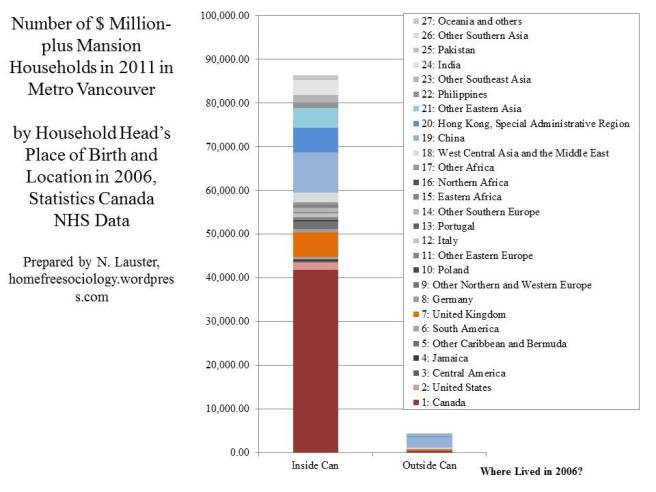New immigration figures have come out from the 2016 Canadian Census! I should know: I spent three hours Wednesday talking about them on local CBC afternoon radio shows across Canada. To modify the great Johnny Cash…
I’ve been everywhere, man, I’ve been everywhere…
I’ve been to Toronto, London, St. John’s, Halifax, New Brunswick, Cape Breton, Saskatchewan, Winnipeg, Yellowknife, Calgary, and Montreal.
I’ve been everywhere, man, I’ve been everywhere…
I gave a couple of interviews in Vancouver too, but here people just want to talk to me about housing!
Back to immigration, mostly I was working off the handy Statistics Canada press release from that morning. My main takeaways were that:
- Immigrants to Canada look increasingly like a little miniature version of the world. For instance, our three biggest senders include the two biggest countries in the world (+ the Philippines)
- Immigrants to Canada are increasingly by-passing the big gateway cities (Toronto, Vancouver, and Montreal) and distributing themselves more broadly – especially into the Prairie provinces. Calgary, for instance, now well surpasses Montreal in terms of the proportion of its population foreign-born (29%)!
- Big Canadian cities continue to get more diverse. Most big Canadian metros now approach one quarter of their population made up of immigrants, with Toronto and Vancouver closing in on half (46% & 41%). Toronto continues to serve as the main gateway to the world, with Vancouver as a secondary gateway to the Pacific Rim and Montreal as a special gateway with a decidedly French password.
Unfortunately, I really didn’t get a lot of time to play around with immigration data on my own before talking to everyone about the Statistics Canada reports. This is always a little bit worrying: what if I missed something in my coverage? Finally, two days later, I’m checking my work a bit. Mostly it seems to hold up!
Here’s a simplified distribution of Canada’s new immigrants (arriving 2011-2016) according to birthplace from our last census compared to the distribution of the population of the world (2017 data from the Population Reference Bureau).

Recent Arrivals to Canada really do look a lot like a miniature version of the World as a whole! That’s pretty cool. Most of the variation I can make out concerns Canada attracting slightly MORE immigrants than might be expected from:
- The Caribbean (hello Haiti & Jamaica)
- West Central Asia and the Middle East (a warm welcome to Syrian refugees!)
- Southeast Asia (the Philippines is an emigration powerhouse)
On the other hand, Canada attracts slightly FEWER immigrants than might be expected from:
- Eastern Asia
- Southern Asia
Why are so few Eastern and Southern Asians coming to Canada relative to their proportions in the world as a whole? From the perspective of Vancouver, of course, that seems like a decidedly weird question. Different cities get different mixes of immigrants in Canada, and Vancouver remains the Gateway to the Pacific Rim. Let’s look at the city breakdown.

No surprise: the distribution of immigrants into Vancouver is decidedly Asian – and especially East Asian. Toronto’s newcomers also look quite Asian in origin, but more South Asian than East Asian, and Toronto remains more diverse overall. Still, it seems the African, European and American immigration streams remain a little squished in Toronto relative to the world’s population as a whole. Not so in Montreal! There streams are dominated by arrivals from the Americas, Africa, and Europe in proportions exceeding the world population. Thanks for balancing us out, Montreal! I added Calgary to the mix too, and Calgary really demonstrates how Southeast Asians (again, especially Filipinos) are really filling out Canada’s labor needs as fast the opportunities arise to do so. Otherwise Calgary, like Toronto, looks pretty darn diverse!
Just to demonstrate where immigrants are arriving from in conjunction with where they’re going to, I’ve re-plotted immigrant origins by destinations below, separating out the big gateway cities (I’m adding you, Calgary, because you really shine in this census release. I’m expecting a special thanks from mayor Naheed Nenshi!)

Most recent immigrants are still arriving through the big Gateway cities of Toronto, Vancouver, and Montreal. But these metros are no longer dominating migration quite as much as they used to, and where groups go really varies by their region of origin. Some groups, like immigrants arriving from Southeast Asia, are mostly avoiding the big Gateway cities, heading instead to Calgary and other places actively attempting to recruit them via new and improved provincial migration programs.
And with that, I bid our new immigrants welcome! And I offer up the full version of that Johnny Cash song.




